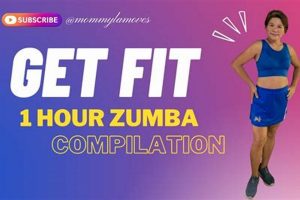This fitness activity merges the energetic dance movements of Zumba with the low-impact bouncing of a trampoline, creating a unique exercise experience. Participants follow choreographed routines on mini-trampolines, combining cardio, muscle toning, and balance work. For example, a typical session involves a warm-up, followed by a series of dance-inspired moves performed on the trampoline, concluding with a cool-down.
The appeal lies in its potential to offer a fun and engaging way to improve cardiovascular health and coordination, and to strengthen muscles. The trampoline element reduces the impact on joints, making it a potentially suitable option for individuals seeking a low-impact workout. Its emergence as a fitness trend reflects a broader interest in innovative and enjoyable exercise formats.
The subsequent sections will delve into the specific health benefits, required equipment, safety considerations, and potential modifications of this exercise approach, providing a well-rounded understanding of what it entails.
Effective Strategies for Zumba Trampoline Exercise
The following guidelines aim to optimize the exercise experience and promote participant safety and efficacy.
Tip 1: Equipment Verification. Ensure the trampoline is specifically designed for fitness use, with sturdy construction and a secure safety pad covering the springs. Regularly inspect for wear and tear before each session.
Tip 2: Proper Footwear. Wear athletic shoes that provide adequate support and grip. Bare feet or socks alone may increase the risk of slipping or injury.
Tip 3: Gradual Introduction. Begin with shorter sessions and simpler routines to allow the body to adapt to the unique demands of bouncing and dance movements. Gradually increase intensity and duration.
Tip 4: Core Engagement. Actively engage core muscles throughout the workout. This enhances stability, improves balance, and protects the spine.
Tip 5: Controlled Movements. Focus on controlled and deliberate movements, avoiding excessive jumping or uncontrolled bouncing. This minimizes the risk of joint strain.
Tip 6: Hydration is Key. Maintain adequate hydration by drinking water before, during, and after the activity. Dehydration can impair performance and increase the risk of muscle cramps.
Tip 7: Listen to the Body. Pay attention to signals of fatigue or discomfort and modify or stop as needed. Pushing through pain can lead to injury.
Implementing these suggestions can enhance the safety and effectiveness of the fitness regimen. Adherence to proper technique and gradual progression are paramount to realizing the potential benefits.
The subsequent section will provide an overview of potential safety considerations and risk mitigation strategies for this activity.
1. Cardiovascular Enhancement
The core element of “zumba trampoline workout” is cardiovascular enhancement. The rhythmic bouncing on the trampoline, combined with dance-inspired movements, elevates heart rate and increases oxygen consumption. This creates a sustained aerobic state, crucial for improving cardiovascular health. A practical example is the increased heart rate variability observed in participants who engage in regular “zumba trampoline workout” sessions, indicating improved autonomic nervous system function and cardiovascular resilience.
The increased cardiovascular demand stimulates various physiological adaptations. These include enhanced blood circulation, improved lung capacity, and strengthened cardiac muscle. Further, the repetitive nature of the routines promotes angiogenesis, the formation of new blood vessels, which contributes to better oxygen delivery to tissues. The integration of interval training within the routines, alternating between high and low-intensity bursts, further maximizes cardiovascular benefits by challenging the heart to adapt to varying demands.
Therefore, the connection between “zumba trampoline workout” and cardiovascular enhancement is direct and significant. The aerobic intensity and rhythmic nature of the activity provide a robust stimulus for improving cardiovascular function, enhancing overall fitness levels, and promoting long-term health. Understanding this relationship allows individuals to appreciate the potential benefits and to engage in the activity with informed awareness.
2. Joint Impact Reduction
Joint impact reduction is a fundamental benefit derived from the integration of a trampoline into the Zumba workout. The elastic surface of the trampoline absorbs a significant portion of the force generated during movement, mitigating stress on weight-bearing joints and offering a gentler exercise modality.
- Energy Absorption
The trampoline mat acts as an energy absorber, dissipating the force of impact upon landing. This reduces the amount of force transmitted to the ankles, knees, hips, and spine. For instance, a jump on a hard surface can generate impact forces several times body weight, while a similar jump on a trampoline significantly reduces this magnitude.
- Proprioceptive Enhancement
The unstable surface of the trampoline activates proprioceptors, specialized sensory receptors in muscles and joints, leading to enhanced balance and coordination. This heightened awareness of body position can improve movement efficiency and further minimize joint stress. This also applies for people who is injured.
- Reduced Ground Reaction Force
The compliant nature of the trampoline results in a lower ground reaction force compared to solid surfaces. This means that the forces exerted back upon the body during exercise are diminished, leading to less compressive loading on joint structures.
- Extended Time of Force Application
The trampoline extends the duration over which force is applied during movement. This temporal distribution of force reduces the peak intensity of impact, allowing the body to adapt more readily and minimizing the potential for joint trauma.
The strategic utilization of the trampoline in Zumba workout offers a means to reduce joint impact, making it an accessible and sustainable exercise option for individuals with joint sensitivities, injuries, or those seeking a lower-impact alternative to traditional high-impact activities. The combination of energy absorption, proprioceptive enhancement, reduced ground reaction force, and extended time of force application contribute synergistically to protect and preserve joint health.
3. Core Muscle Engagement
Core muscle engagement is an indispensable component of “zumba trampoline workout”, contributing significantly to stability, balance, and injury prevention. The inherent instability of the trampoline surface necessitates constant activation of core muscles to maintain postural control. Without adequate core engagement, participants are at increased risk of losing balance and sustaining injuries, particularly to the lower back and ankles. The dynamic movements characteristic of Zumba, when performed on a trampoline, demand continuous adjustments by the core musculature to counteract the shifting center of gravity. For example, a Zumba routine incorporating quick turns and lateral movements on the trampoline requires the transverse abdominis, obliques, and erector spinae to work synergistically to stabilize the spine and prevent excessive rotation or flexion. Real-life examples of participants who neglect core engagement often demonstrate compensatory movement patterns, such as relying heavily on momentum or exhibiting poor posture, which can lead to musculoskeletal strain over time.
The benefits of core muscle engagement in this context extend beyond stability. Enhanced core strength translates to improved power transfer throughout the body, allowing for more efficient execution of Zumba steps. This leads to increased calorie expenditure and improved cardiovascular conditioning. Furthermore, a strong core acts as a shock absorber, reducing the impact transmitted through the spine and lower extremities, thus complementing the joint impact reduction afforded by the trampoline itself. Instructors who emphasize proper core activation techniques, such as drawing the navel towards the spine and maintaining a neutral spine posture, can significantly enhance the effectiveness and safety of the “zumba trampoline workout”. For instance, incorporating exercises that directly target core muscles, such as planks and pelvic tilts, as part of the warm-up routine can prime the core for the demands of the workout.
In summary, core muscle engagement is not merely an ancillary aspect of “zumba trampoline workout” but rather a foundational element that underpins its safety and efficacy. By actively engaging the core, participants can maximize the benefits of the workout while minimizing the risk of injury. The challenges associated with maintaining consistent core activation on an unstable surface can be addressed through proper instruction, mindful practice, and progressive increases in intensity. This understanding underscores the importance of a holistic approach to “zumba trampoline workout”, one that prioritizes not only cardiovascular fitness and joint health but also the crucial role of core stability in achieving optimal results.
4. Balance and Coordination
The integration of “zumba trampoline workout” inherently emphasizes balance and coordination, serving as critical determinants of both participant safety and the efficacy of the exercise routine. The dynamic and unstable surface of the trampoline necessitates constant adjustments to maintain equilibrium, directly challenging and enhancing an individual’s proprioceptive abilities and neuromuscular control.
- Vestibular System Stimulation
The trampoline’s bouncing motion provides significant stimulation to the vestibular system, located in the inner ear. This system is responsible for detecting changes in head position and orientation in space, playing a crucial role in maintaining balance. The varied movements in a Zumba routine, coupled with the trampoline’s instability, require the vestibular system to continuously process and respond to changes in equilibrium, thereby enhancing its functionality. For instance, complex Zumba steps involving turns or changes in direction demand rapid and accurate processing by the vestibular system to prevent loss of balance.
- Proprioceptive Feedback Enhancement
Proprioception, the body’s ability to sense its position and movement in space, is heightened during “zumba trampoline workout”. The unstable surface necessitates constant adjustments in muscle activation to maintain postural stability. This heightened proprioceptive demand leads to improved awareness of body position and movement patterns, facilitating more precise and coordinated movements. Individuals may notice enhanced agility and responsiveness in their everyday activities as a result of this improved proprioceptive feedback.
- Neuromuscular Coordination Improvement
The combination of Zumba choreography and trampoline instability requires the nervous system to coordinate muscle activation patterns with greater precision. This leads to enhanced neuromuscular coordination, the ability of the brain to effectively communicate with muscles to produce smooth, controlled movements. The complex and rapid changes in direction and tempo characteristic of Zumba routines challenge the neuromuscular system to adapt and respond quickly, resulting in improved motor control and coordination skills.
- Enhanced Postural Control
Sustained engagement in “zumba trampoline workout” promotes improved postural control, the ability to maintain balance and stability during static and dynamic activities. The constant need to adjust posture on the unstable surface strengthens the muscles responsible for maintaining upright posture, leading to greater stability and reduced risk of falls. This benefit is particularly relevant for older adults or individuals with balance impairments.
The collective benefits of vestibular stimulation, proprioceptive feedback enhancement, neuromuscular coordination improvement, and enhanced postural control underscore the significance of “zumba trampoline workout” as a modality for improving balance and coordination. The dynamic and unstable environment created by the trampoline provides a unique challenge that effectively enhances these critical aspects of motor control, leading to improved physical function and reduced risk of injury.
5. Calorie Expenditure
Calorie expenditure during “zumba trampoline workout” is a significant factor attracting individuals seeking effective weight management and fitness improvement. The activity’s unique combination of cardiovascular exercise and dynamic movement patterns contributes to a substantial energy demand, potentially exceeding that of some traditional exercise modalities.
- Metabolic Rate Elevation
The sustained aerobic activity involved in “zumba trampoline workout” elevates the metabolic rate, both during and after the exercise session. This increased metabolic rate results in a higher caloric burn, facilitating weight loss or maintenance. For example, studies have shown that individuals participating in regular aerobic exercise, such as Zumba, experience a prolonged elevation in resting metabolic rate, contributing to a greater overall calorie deficit.
- Muscle Activation and Energy Demand
The trampoline component of the workout engages a broader range of muscle groups, particularly those responsible for stabilization and balance. This increased muscle activation translates to a higher energy expenditure. The constant adjustments required to maintain balance on the unstable surface demand continuous engagement from core muscles, leg muscles, and even smaller stabilizing muscles, all contributing to the overall caloric burn. This can be contrasted with Zumba on a stable surface, where less compensatory muscle activation is required.
- Intensity and Duration Impact
The intensity and duration of the “zumba trampoline workout” directly influence the total calorie expenditure. Higher intensity routines, characterized by faster tempos and more complex movements, will naturally result in a greater caloric burn per unit time. Similarly, longer workout sessions will increase the overall energy demand. Individual calorie expenditure will be dependent on the participant’s weight, fitness level, and the specific intensity and duration of the session.
- Excess Post-exercise Oxygen Consumption (EPOC)
The vigorous nature of the exercise contributes to a significant EPOC effect, also known as the “afterburn effect”. This refers to the elevated oxygen consumption and calorie expenditure that persists after the workout has concluded. The body requires additional energy to recover from the exercise, repair muscle tissue, and restore physiological homeostasis, resulting in a continued caloric burn for several hours post-exercise. This prolonged elevation in energy expenditure contributes significantly to the overall effectiveness of “zumba trampoline workout” for weight management and fitness improvement.
In summary, calorie expenditure during “zumba trampoline workout” is influenced by a combination of factors, including metabolic rate elevation, muscle activation, exercise intensity and duration, and the EPOC effect. The unique combination of Zumba choreography and trampoline instability results in a substantial energy demand, making it an effective exercise modality for those seeking to manage their weight, improve their fitness level, and increase their overall caloric burn.
6. Choreographic Routines
The choreographic routines within a “zumba trampoline workout” framework are fundamental to its structure, engagement, and overall effectiveness. These carefully designed sequences of movements not only dictate the physical demands of the workout but also contribute significantly to its motivational and enjoyable aspects.
- Variety and Engagement
The integration of diverse dance styles and rhythms within the choreographic routines provides a stimulating and engaging exercise experience. By incorporating elements from salsa, merengue, hip-hop, and other dance forms, the workout caters to a broad range of preferences and maintains participant interest. This variety minimizes the risk of monotony and promotes long-term adherence to the exercise program. For instance, a routine may alternate between high-energy Latin rhythms and slower, more controlled hip-hop sequences, challenging different muscle groups and cognitive skills. This contrasts with repetitive, single-modality exercises that often lead to boredom and attrition.
- Structured Progression and Intensity
Choreographic routines enable a structured progression of intensity, allowing participants to gradually increase the physical demands of the workout. Routines are often designed with a clear warm-up, peak intensity phase, and cool-down sequence, ensuring that the body is adequately prepared for and recovered from the exercise. The instructor can modify the choreography to accommodate different fitness levels, ensuring that all participants can safely and effectively engage in the workout. For example, modifications may involve reducing the amplitude of jumps, slowing down the tempo, or simplifying complex steps. This adaptability is critical for promoting inclusivity and preventing injuries.
- Cognitive Engagement and Coordination
Learning and executing choreographic routines stimulates cognitive function and enhances coordination skills. Participants must actively focus on memorizing sequences of steps, coordinating their movements with the music, and maintaining their balance on the unstable trampoline surface. This cognitive engagement contributes to improved memory, attention, and motor control. For instance, a complex sequence involving multiple directional changes and footwork patterns requires sustained concentration and precise coordination, providing a mental workout in addition to the physical benefits.
- Musicality and Expression
The close synchronization of movements with music enhances the emotional and expressive aspects of the “zumba trampoline workout”. The choreography is specifically designed to complement the rhythms and melodies of the music, creating a synergistic effect that amplifies the enjoyment and motivation of the participants. This musicality fosters a sense of freedom and self-expression, transforming the workout into a more engaging and rewarding experience. For example, a routine set to a fast-paced salsa track may encourage participants to embrace the energy and passion of the music, leading to a more vigorous and fulfilling workout.
These elements, collectively, underscore the significant role of choreographic routines in shaping the “zumba trampoline workout” experience. By offering variety, structured progression, cognitive engagement, and musicality, these routines contribute to the workout’s effectiveness, adherence, and overall appeal. The careful design and implementation of these routines are therefore essential for maximizing the potential benefits of this exercise modality.
7. Safety Precautions
Safety precautions are of paramount importance within the context of “zumba trampoline workout”. The combination of rhythmic dance movements and the inherently unstable surface of a trampoline introduces specific risks that necessitate careful consideration and proactive mitigation strategies.
- Trampoline Integrity and Suitability
The structural integrity and suitability of the trampoline are fundamental safety considerations. The equipment must be specifically designed for fitness purposes, featuring a robust frame, durable jumping surface, and secure spring or bungee cord system. Regular inspection for signs of wear, tear, or damage is essential. The use of recreational trampolines lacking adequate safety features is strongly discouraged. An example is the examination of the spring to prevent incident due to the spring weariness.
- Proper Footwear and Attire
Appropriate footwear and attire are critical for minimizing the risk of slips, trips, and falls. Participants should wear athletic shoes that provide adequate support, cushioning, and grip. Bare feet or socks alone are not recommended due to the increased risk of slippage. Loose clothing should be avoided as it can impede movement and potentially become entangled in the trampoline. Attire is about the comfort to move and fitness.
- Controlled Movement and Gradual Progression
The execution of controlled movements and a gradual progression of intensity are essential for preventing injuries. Participants should avoid excessive jumping, uncontrolled bouncing, or attempting complex maneuvers beyond their skill level. Beginning with simpler routines and gradually increasing the difficulty and intensity allows the body to adapt to the demands of the workout, minimizing the risk of muscle strains, sprains, and other musculoskeletal injuries. Beginner have to know the pace level of the exercise.
- Supervision and Instruction
Qualified supervision and instruction play a vital role in ensuring participant safety. A certified instructor can provide guidance on proper technique, demonstrate modifications for different fitness levels, and monitor participants for signs of fatigue or distress. The presence of a trained supervisor allows for prompt intervention in the event of an emergency. Trainer have to give warning or reminder about the exercise.
These facets, while distinct, are interconnected and collectively contribute to a safer “zumba trampoline workout” experience. Adherence to these precautions minimizes the risk of injury and maximizes the potential benefits of this unique fitness modality. The proactive implementation of these measures is a shared responsibility between instructors and participants, fostering a safe and supportive environment for physical activity.
Frequently Asked Questions
This section addresses common inquiries regarding the Zumba Trampoline Workout, providing factual information to enhance understanding and promote informed participation.
Question 1: Is Zumba Trampoline Workout suitable for individuals with pre-existing joint conditions?
The reduced impact nature of the trampoline may offer benefits; however, consultation with a healthcare professional prior to participation is strongly advised. Individual joint health status and the specific exercise modifications are crucial factors.
Question 2: What are the essential equipment requirements for Zumba Trampoline Workout?
A fitness-grade mini-trampoline with a secure safety pad is the primary requirement. Athletic shoes providing adequate support and grip are also essential. The surrounding area should be free of obstructions.
Question 3: How does Zumba Trampoline Workout compare to traditional Zumba in terms of calorie expenditure?
Calorie expenditure can vary based on intensity and individual factors. The added instability of the trampoline may lead to increased core muscle engagement and potentially higher caloric burn, but direct comparisons require controlled studies.
Question 4: What are the potential risks associated with Zumba Trampoline Workout?
Potential risks include ankle sprains, knee injuries, and lower back pain. Proper technique, gradual progression, and adherence to safety guidelines are essential for risk mitigation.
Question 5: How often should one participate in Zumba Trampoline Workout to experience noticeable benefits?
Consistency is key. Three to five sessions per week, lasting at least 30 minutes each, may yield noticeable improvements in cardiovascular fitness, balance, and muscle strength. However, individual responses may vary.
Question 6: Can Zumba Trampoline Workout be modified for different fitness levels?
Yes, modifications are possible and should be implemented to accommodate varying fitness levels. Instructors can adjust the amplitude of jumps, the complexity of steps, and the tempo of the routines to ensure accessibility and safety for all participants.
Zumba Trampoline Workout presents a unique exercise approach. While offering potential benefits, careful consideration of individual health status, safety precautions, and proper technique is paramount.
This concludes the frequently asked questions section. The following section will explore advanced considerations for Zumba Trampoline Workout.
Conclusion
This exploration has detailed various facets of the “zumba trampoline workout”, encompassing its benefits, potential risks, and essential considerations. From its cardiovascular and joint-friendly nature to its emphasis on core engagement and balance, the activity presents a multi-faceted approach to fitness. The information presented serves to provide a comprehensive understanding of this unique exercise modality.
In summation, “zumba trampoline workout” represents an evolving trend in fitness. Further research and standardized training protocols will be instrumental in maximizing its potential and ensuring participant safety. Individuals are encouraged to approach this activity with informed awareness and prioritize professional guidance to achieve optimal results.







